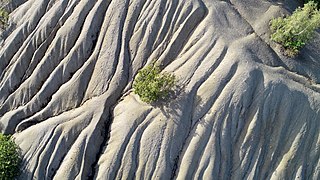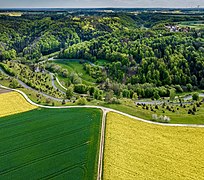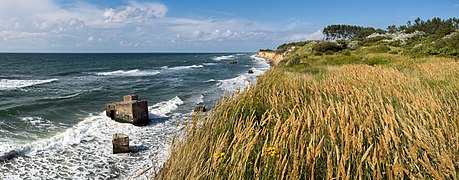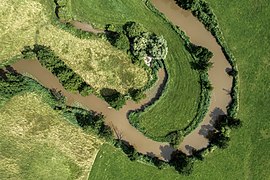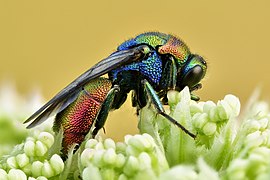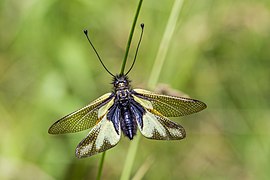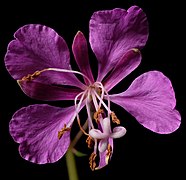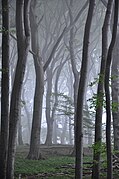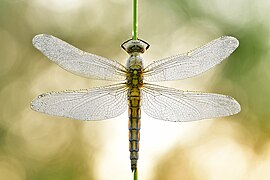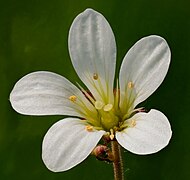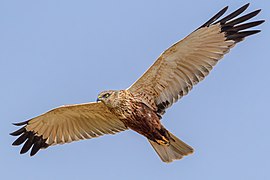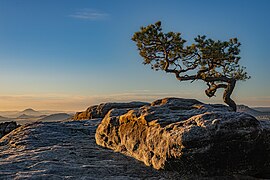User talk:Thiotrix
|
|
Cladophoropsis sundanensis
[edit]Hello,
I just noticed this change. Can you tell me the reason of this ? The picture was identified by a professional, so I would like to be sure that this change is at the same level of accuracy.
Thanks and best regards, FredD (talk) 13:13, 6 January 2020 (UTC)
- Hello FredD, this does not mean that the identification is incorrect. The categorization at Commons is based on AlgaeBase, which lists Cladophoropsis sundanensis as a synonym of Cladophoropsis fasciculata. Kind regards, --Thiotrix (talk) 13:34, 6 January 2020 (UTC)
- Ok, I'm not used to AlgaeBase so I just saw there was a valid page but did not notice the synonymy - it is much clearer on WoRMS... Thanks and happy new year, FredD (talk) 13:19, 9 January 2020 (UTC)
2 categories
[edit]Dear Thiotrix,
If you have some time, please give some taxanomic data for these 2 categories. I got 2 images for thm.
Best Regards, --Leoboudv (talk) 08:03, 17 January 2020 (UTC)
- Thanks for your kind help Thiotrix. Best, --Leoboudv (talk) 10:19, 17 January 2020 (UTC)

|
Cotyledons (leaves) has been listed at Commons:Categories for discussion so that the community can discuss ways in which it should be changed. We would appreciate it if you could go to voice your opinion about this at its entry. If you created this category, please note that the fact that it has been proposed for discussion does not necessarily mean that we do not value your kind contribution. It simply means that one person believes that there is some specific problem with it. If the category is up for deletion because it has been superseded, consider the notion that although the category may be deleted, your hard work (which we all greatly appreciate) lives on in the new category. In all cases, please do not take the category discussion personally. It is never intended as such. Thank you! |
Estopedist1 (talk) 19:44, 5 February 2020 (UTC)
Dear Thiotrix,
Please help give some taxanomic data for this category if possible. And take care and stay safe in this difficult time. Best Regards, --Leoboudv (talk) 07:30, 25 April 2020 (UTC)
 Done. And good wishes for health for you too, Leoboudv. Kind regards,--Thiotrix (talk) 17:54, 25 April 2020 (UTC)
Done. And good wishes for health for you too, Leoboudv. Kind regards,--Thiotrix (talk) 17:54, 25 April 2020 (UTC)
- Thank you for your help and thank you for your wishes Thiotrix. Many people are need help in this difficult time. Best, --Leoboudv (talk) 18:46, 25 April 2020 (UTC)
 Comment: The Washington Post is giving free coverage for all COVID related articles on their website and according to this link, more than 200,000 people died today (Saturday) of this virus sadly. Regards, --Leoboudv (talk) 18:48, 25 April 2020 (UTC)
Comment: The Washington Post is giving free coverage for all COVID related articles on their website and according to this link, more than 200,000 people died today (Saturday) of this virus sadly. Regards, --Leoboudv (talk) 18:48, 25 April 2020 (UTC)
Bomaria in Costa Rica
[edit]Hi, are you sure that this Photo in not Bomarea acutifolia ? --Salix (talk) 17:11, 1 May 2020 (UTC)

- I am nearly sure. I made video of a Colibri (Colibri thalassinus = Colibri cyanotus) visiting the plants. His beak (length = 21 mm) is full in the flower. According to Flora Mesoamericana, flowers of Bomarea acutifolia should be greater with petals of 26-39 mm long. Why do you think, this could be Bomarea acutifolia? I have more photos not yet on Commons to compare. Kind regards, --Thiotrix (talk) 17:47, 1 May 2020 (UTC)

- Thanks Thiotrix. Both files are named "Bomarea sp". Would you like me to rename them more precisely ? --Salix (talk) 18:08, 2 May 2020 (UTC)
- If you think that a "90% identification" is sufficient, you can rename them. And thank you for your identification of Wigandia urens and the grass Lasiacis. (You renamed it "Poaceae (Lacis sp. ?) in Costa Rica.jpg", this is probably an error?) By the way, do you have any idea, what File:CR302 shrub Costa Rica.JPG could be? --Thiotrix (talk) 11:20, 3 May 2020 (UTC)
- Thanks Thiotrix. Both files are named "Bomarea sp". Would you like me to rename them more precisely ? --Salix (talk) 18:08, 2 May 2020 (UTC)
2 categories
[edit]Dear Thiotrix,
If you can, please give taxanomic data for these 2 categories below.
Best Regards, --Leoboudv (talk) 18:57, 2 May 2020 (UTC)
 Done, and thank you for uploading. Kind regards, --Thiotrix (talk) 11:53, 3 May 2020 (UTC)
Done, and thank you for uploading. Kind regards, --Thiotrix (talk) 11:53, 3 May 2020 (UTC)
- Thanks for your help Thiotrix. Best Regards, --Leoboudv (talk) 18:54, 7 May 2020 (UTC)
1 category
[edit]Dear Thiotrix,
Please give taxanomic data for this new category when you can.
I found some data here: http://www.speciesfungorum.org/Names/SynSpecies.asp?RecordID=809933
Thank You, --Leoboudv (talk) 21:17, 14 June 2020 (UTC)
- Thank You Thiotrix for all your help. Best Regards, --Leoboudv (talk) 19:55, 1 July 2020 (UTC)
- Hello Leoboudv, I was absent from the wiki for some holidays. So it was not me, but thanks to user:Strobilomyces, who added the taxonomic data. Have a good time, kind regards, --Thiotrix (talk) 07:20, 2 July 2020 (UTC)
- Thank you both Strobilomyces and you Thiotrix for your kind help. It is always appreciated. Best Regards from Canada, --Leoboudv (talk) 00:56, 4 July 2020 (UTC)
Identification of File:Clitocybe dealbata gljiva.jpg
[edit]Hello. I am sure that the mushroom in the photo above is not a Clitocybe (it has pink spores). Please could you look at the talk page? Strobilomyces (talk) 10:15, 17 September 2020 (UTC)
1 category
[edit]Dear Thiotrix,
If you have the time, please create a category for Category:Xylaria kegeliana
This horrible year 2020 has closed my University, UBC, in Vancouver, Canada due to covid-19 and many people have lost their jobs or income...or worse still their lives. Hopefully 2021 will be a better year. May I wish you a Happy 2021 Thiotrix!
Best Wishes from Metro Vancouver, Canada, --Leoboudv (talk) 03:36, 31 December 2020 (UTC)
- The new category is done. Yes, 2020 was strange! We all hope, that 2021 will be better, and that the beginning vaccinations will help to overcome the terror of the pandemy. Stay safe and healthy, Leoboudv, and a Happy New Year to you. --Thiotrix (talk) 15:41, 31 December 2020 (UTC)
- Thank You very much Thiotrix for your help. Best Regards, --Leoboudv (talk) 20:00, 31 December 2020 (UTC)
Category:Special Areas of Conservation in Landkreis Kassel
[edit]Hallo, wg.
das NSG war und ist doch bereits in der NSG-Kat. was soll das bzw. diese Kat. jetzt leisten? ... mit fragenden Gruß ... Baummapper (talk) 15:08, 22 April 2021 (UTC)
- Hallo Baummapper, der Baunsberg ist ja gleichzeitig auch noch FFH-Gebiet, und das sind auf englisch die "Special areas of Conservation". Grüße von --Thiotrix (talk) 16:14, 22 April 2021 (UTC)
- Ganz so einfach ist das nicht, und daher geht da auch in Commons vieles ungenau durcheinander es gibt
- - das NSG "Baunsberg" Kennung: 1633009 Fläche: 25,49 ha
- - das FFH-Gebiet "Baunsberg" Kennung: 4722-303 Fläche: 28,91 ha
- schon an der Größe ist zu erkennen, dass diese trotz Namensgleichheit *unterschiedlichen* Schutzgebiets-Typen dort nicht genau deckungsgleich sind, sieht man auch auf den Kartendarstellungen. Man muss sich da schon jeden Einzelfall anschauen, um eine sinnvolle Lösung zu finden.
- Wenn ich für das FFH-Gebiet "Baunsberg" eine Commons-Kat haben wollte, würde ich diese anlegen, mit einer verständlichen und klärenden Kategorie-Beschreibung: "Das FFH-Gebiet "Baunsberg" Kennung: 4722-303 (28,91 ha) ist weitestgehend identisch mit der Fläche des älteren NSG "Baunsberg" Kennung: 1633009 (25,49 ha)" Category:Naturschutzgebiet Baunsberg wäre dort dann als Unterkategorie einzuordnen.
- Eine NSG-Kat. mal so nebenbei als FFH-Gebiet einzuordnen ist imho Murks - sorry. ... Baummapper (talk) 16:19, 26 April 2021 (UTC)
- Die leicht unterschiedliche Fläche von NSG und FFH war mir bewusst, aber immerhin ist ja das NSG komplett im FFH enthalten, bzw, darin aufgegangen. Die Kategorien bei Commons dienen ja in erster Linie dazu, dass die Bilder gefunden werden können. Ich habe das NSG Baunsberg bei den FFH-Gebieten um Kassel "eingehängt", damit man nicht denkt, für das FFH Baunsberg gäbe es noch keine Fotos. Wenn du magst, erstelle halt die extra Kategorie für das FFH. Gruß, --Thiotrix (talk) 19:11, 26 April 2021 (UTC)
- Eine NSG-Kat. mal so nebenbei als FFH-Gebiet einzuordnen ist imho Murks - sorry. ... Baummapper (talk) 16:19, 26 April 2021 (UTC)
- Ja, das FFH-Gebiet ist hier NSG + x und dies ist in der Mehrzahl so, mitunter sind auch mehrere NSG inkludiert, mitunter auch ein oder mehrere ND Die sind dann aber keineswegs darin "aufgegangen". Daher sind NSG und ND sinnvollerweise i.d.R. Unterkategorien der jeweiligen FFH-Kats.
- Und ja, der Eindruck, dass es von einem FFH-Gebiet keine Bilder gibt sollte vermieden werden, kümmere mich gegenwärtig um NSG und ND, deren FFH-Einordnung habe ich zugegebenermaßen bisher vernachlässigt...
- Habe mal dieses FFH-Gebiet exemplarisch ergänzt und die 2 vorhandenen NSG-Kats dort eingeordnet:
- Gruß ... Baummapper (talk) 14:25, 27 April 2021 (UTC)
@Thiotrix:
Guten Tag Thiotrix,
könntest Du bitte einen Blick auf den Artikel Bulbophyllum werfen.
Bulbophyllum zählt zu den Gattungen mit besonders vielen Arten. Die Seite Bulbophyllum war beim Seitenaufbau und bei der Bearbeitung schon sehr langsam geworden.
Ich habe diese Gattung (als Versuch) in Unter-Artikel mit alphabetischer Sortierung der Arten aufgeteilt.
Über Deine Meinung, Anregungen, Verbesserungsvorschläge oder Kritik werde ich mich freuen.
Beste Grüße. Orchi (talk) 17:13, 7 May 2021 (UTC)
- Hallo Orchi,
- bei so großen Gattungen ist eine Unterteilung sicher eine zweckmäßige Lösung. Bei anderen artenreichen Gattungen wie Euphorbia und Rhododendron sind zwar bislang noch sämtliche Arten in einer Seite enthalten. Aber vielleicht sind dort auch noch nicht so viele Arten fotografiert worden wie bei den Orchideen.
- Eine einfache Möglichkeit wäre, die umfangreiche Bulbophyllum-Seite in zwei oder drei Unterseiten (z.B. A-H, I-P, Q-Z) aufzuteilen. Wenn du gleich eine Unterseite für jeden Buchstaben anlegen möchtest, ist das vorausschauend gedacht und somit ebenfalls ok. Bei deiner Gestaltung der Hauptseite fällt mir nur auf, dass die immer gleichen Fotos außer den Buchstaben nicht so viel bringen. Als weitere Alternative könnte man die Startseite auch ähnlich wie bei Wikispecies gestalten: ein größeres Foto und eine alphabetische Liste der Arten, mit Links sowohl zur Galerie jedes Buchstabens als auch zu jeder Art, etwa so:
- a (Bulbophyllum a gallery)
- * Bulbophyllum absconditum, Bulbophyllum affine, Bulbophyllum agastor ..... oder
- Das erspart den Nutzern vielleicht einen zusätzlichen Klick, wenn sie nachsehen möchten, ob es zu einer Art der Gattung schon Fotos gibt. Probier einfach mal aus, was hier am besten funktioniert. Herzliche Grüße von --Thiotrix (talk) 12:53, 8 May 2021 (UTC)
- Hallo Thiotrix,
- vielen Dank für Deine Nachricht mit den verschiedenen Vorschlägen zur Gestaltung eines umfangreichen Gattungsartikels.
- Ich werde mir in den nächsten Tage nochmals ein paar Gedanken dazu machen.
- Eine optische Unterscheidung zwischen Galerie und Kategorie halte ich persönlich für vorteilhaft.
- Mal' sehen, wie es generell mit den Commons galleries weitergeht. Es ist ja so einfach, Bilder in Kategorien unterzubringen.
- Auch sind z.B. User und Bots in der italienischen und spanischen Wikipedia aktiv, die Links zu Commons-Artikel gänzlich zu entfernen und dafür jeder Seite zwei Links zur entsprechenden Kategorie zuzuordnen.
- Es geht wohl nirgends mehr ohne die Roboter.
- Nochmals vielen Dank und beste Grüße. Orchi (talk) 17:13, 9 May 2021 (UTC)
- Hallo Thiotrix,
We need your feedback!
[edit]Hello. Apologies if this message is not in your native language: please feel free to respond in the language of your choice. Thank you!
I am writing to you because we are looking for feedback for a new Wikimedia Foundation project, Structured Data Across Wikimedia (SDAW). SDAW is a grant-funded programme that will explore ways to structure content on wikitext pages in a way that will be machine-recognizable and -relatable, in order to make reading, editing, and searching easier and more accessible across projects and on the Internet. We are now focusing on designing and building image suggestion features for experienced users.
We have some questions to ask you about your experience with uploading images here on Wikimedia Commons and then adding them to Wikipedia. You can answer these questions on a specific feedback page on Mediawiki, where we will gather feedback. As I said, these questions are in English, but your answers do not need to be in English! You can also answer in your own language, if you feel more comfortable.
Once the collecting of feedback will be over, we will sum it up and share with you a summary, along with updated mocks that will incorporate your inputs.
Also, if you want to keep in touch with us or you want to know more about the project, you can subscribe to our newsletter.
Hope to hear from you soon! -- Sannita (WMF) (talk to me!) 09:57, 2 August 2021 (UTC)
Wiki Loves Earth 2022 - Deutschland
[edit]Hallo Thiotrix,
bald ist es soweit: Vom 1. Mai bis zum 31. Mai 2022 findet zum zehnten Mal der internationale Wettbewerb Wiki Loves Earth statt. Deutschland ist bereits zum neunten Mal dabei. Dabei können unter anderem Nationalparks, Naturschutzgebiete, Geotope und Naturdenkmäler fotografiert und die Fotos hochgeladen werden. Du hast an einem der vergangenen Fotowettbewerbe teilgenommen. Deshalb laden wir dich ein, auch dieses Jahr wieder mitzumachen. Wir freuen uns auf deine Fotos!
Seit dem vergangenen Jahr ist der Wettbewerb zweigeteilt, das heißt wir unterscheiden zwischen den beiden Bereichen Landschaft und Detail/Makro. Zu Landschaft zählen auch geschützte Einzelbäume. Im Bereich Detail/Makro werden Pflanzen, Tiere und Pilze bewertet.
Es sind wie immer viele spannende Motive überall in Deutschland zu finden. Neben Naturdenkmälern wie alten Bäumen oder Naturparks im Gebirge und am Meer können Geotope wie Findlinge, Quellen und Aufschlüsse oder FFH-Gebiete fotografiert werden, um sie unter anderem in der Wikipedia zu dokumentieren. Auch im vergangenen Jahr sind zahlreiche neue Listen und Artikel in diesen Bereichen entstanden, für die wir uns über Fotos freuen - zum Beispiel in Bayern Liste der Naturdenkmäler im Landkreis Würzburg oder in Sachsen Liste der Naturdenkmale in Stollberg/Erzgeb.
Als Einstieg für die Suche nach Motiven hilft diese Übersichtsseite. Weitere Informationen erhältst du bei WLE 2022 – Deutschland und unter dieser Anleitung.
In diesem Jahr feiert die FFH-Richtlinie ihren 30. Geburtstag. Aus diesem Grund vergeben wir fünf Sonderpreise für die Fotografen, die die meisten FFH-Gebiete fotografieren.
Außerdem laden wir Dich ein, vom 1. Mai bis 30. Juni 2022 an der Vorjury teilzunehmen. Damit bewertest du die hochgeladenen Bilder und ermittelst so gemeinsam mit der Jury, die im Juli tagen wird, die Sieger von Wiki Loves Earth 2022 in Deutschland. Das Vorjurytool ist bald hier freigeschaltet. Du benötigst dafür nur deinen Benutzernamen und das Passwort.
Für Fragen steht das Organisationsteam gerne auf der Support-Seite zur Verfügung.
Viel Spaß und Erfolg beim Fotowettbewerb wünscht dir im Namen des Organisationsteams --Z thomas 12:07, 20 April 2022 (UTC)

|
Acmella radicans has been listed at Commons:Categories for discussion so that the community can discuss ways in which it should be changed. We would appreciate it if you could go to voice your opinion about this at its entry. If you created this category, please note that the fact that it has been proposed for discussion does not necessarily mean that we do not value your kind contribution. It simply means that one person believes that there is some specific problem with it. If the category is up for deletion because it has been superseded, consider the notion that although the category may be deleted, your hard work (which we all greatly appreciate) lives on in the new category. In all cases, please do not take the category discussion personally. It is never intended as such. Thank you! |
2400:1A00:B111:CBF8:1D48:9B88:4CAD:1D01 03:46, 29 June 2022 (UTC)
Jarilla
[edit]Are you confident that these images are of the genus Jarilla? Jarilla is also a Spanish common name for Larrea.
Plantdrew (talk) 00:52, 28 September 2022 (UTC)
- Hello Plantdrew, thank you for your notice. You are right, this plant probably does not belong to genus Jarilla. But it is neither a Larrea (which have yellow flowers with 5 petals). The flowers here have 4 white petals, so this seems to be something different. I will categorize the images as unidentified. --Thiotrix (talk) 08:02, 28 September 2022 (UTC)
Wiki Loves Earth 2023 - Deutschland
[edit]Hallo Thiotrix,
bald ist es soweit: Vom 1. Mai bis zum 31. Mai 2023 findet zum elften Mal der internationale Wettbewerb Wiki Loves Earth statt. Dabei können unter anderem Nationalparks, Naturschutzgebiete, Geotope und Naturdenkmäler fotografiert und die Fotos hochgeladen werden. Du hast an einem der vergangenen Fotowettbewerbe teilgenommen. Deshalb laden wir dich ein, auch dieses Jahr wieder mitzumachen. Wir freuen uns auf deine Fotos!
Der Wettbewerb ist zweigeteilt, das heißt wir unterscheiden zwischen den beiden Wettbewerbskategorien Landschaft und Detail/Makro. Zu Landschaft zählen auch geschützte Einzelbäume. In der Wettbewerbskategorie Detail/Makro werden Pflanzen, Tiere und Pilze bewertet.
Es sind wie immer viele spannende Motive überall in Deutschland zu finden. Neben Naturdenkmälern wie alten Bäumen oder Naturparks im Gebirge und am Meer können Geotope wie Findlinge, Quellen und Aufschlüsse oder FFH-Gebiete fotografiert werden, um sie unter anderem in der Wikipedia zu dokumentieren. Auch im vergangenen Jahr sind zahlreiche neue Listen und Artikel in diesen Bereichen entstanden, für die wir uns über Fotos freuen – zum Beispiel in Sachsen die Liste der Naturdenkmale in Wurzen.
Als Einstieg für die Suche nach Motiven hilft diese Übersichtsseite. Weitere Informationen erhältst du bei WLE 2023 – Deutschland und unter dieser Anleitung.
Damit der Upload für dich einfacher ist, haben wir in diesem Jahr die einzelnen Hochladeseiten für die Bundesländer abgeschafft, alle Fotos werden über dasselbe Formular hochgeladen. Außerdem haben wir das Layout unserer WLE-Seiten geändert.
Damit es ab 1. Mai mit dem Upload schnell geht:
Außerdem laden wir dich ein, vom 1. Mai bis 30. Juni 2023 an der Vorjury teilzunehmen. Damit bewertest du die hochgeladenen Bilder und ermittelst so gemeinsam mit der Jury, die im Juli tagen wird, die Sieger von Wiki Loves Earth 2023 in Deutschland. Das Vorjurytool ist bald hier freigeschaltet. Du benötigst dafür nur deinen Benutzernamen und das Passwort.
Für Fragen steht das Organisationsteam gerne auf der Support-Seite zur Verfügung. Falls du im nächsten Jahr keine Einladung für Wiki Loves Earth Deutschland haben möchtest, trag dich bitte hier ein. Wir würden das natürlich schade finden, da wir uns auf deine Fotos freuen.
Viel Spaß und Erfolg beim Fotowettbewerb 2023 wünscht dir im Namen des Organisationsteams --Z thomas 15:25, 18 April 2023 (UTC)
Nice foto of a brook meandering
[edit]Thanks! --Silvicola (talk) 12:47, 16 May 2023 (UTC)
Thank you
[edit]Hello, and thanks for your added precisions in Category:Adenanthera bicolor. Very very useful to have all these names + links for such an elusive species. Pueblo89 (talk) 13:42, 18 May 2023 (UTC)
monophyletische Taxa in Commons
[edit]Hallo Thiotrix. Vielen Dank für das Ausfüllen und Verbessern meiner Kategorien. In der de:wiki wird ja immer das niedrigste Taxon bei monophyletischen Ordnung/Familie/Gatttung angelegt, bei Commons habe ich noch keine einheitliche Linie gesehen. Weißt du da mehr? Danke und viele Grüße --Josef Papi (talk) 11:02, 24 September 2023 (UTC)
- Hallo Josef Papi, wir versuchen auch bei den Commons möglichst das niedrigste Taxon zu kategorisieren. Dafür wurde 2012 die Vorlage Template:Monotypic taxon category redirect geschaffen. Wenn nämlich später noch weitere Arten beschrieben werden, muss man nicht alles neu kategorisieren. So machen es tatsächlich auch alle anderen Sprachversionen von Wikipedia – außer der englischen. Bearbeiter der englischen Wikipedia kategorisieren, wie sie es gewohnt sind, daher ist es bei den Commons insgesamt etwas uneinheitlich. In Wikidata wird ja sowieso für jeden Rang ein eigenes Item angelegt. Auch Wikispecies bekommt für jeden Rang einen eigenen Artikel, da es dort um die Nomenklatur geht. Viele Grüße von --Thiotrix (talk) 11:25, 24 September 2023 (UTC)
Somethinhg wrong is with wikidata infobox. I do not know how wikidata infoboxes works and I can't fix it (I made one once but forgot how...). Kenraiz (talk) 00:16, 16 November 2023 (UTC)
- The problem is now fixed. Thanks for your notice. --Thiotrix (talk) 11:36, 16 November 2023 (UTC)
Wiki Loves Earth 2024 - Deutschland
[edit]Hallo Thiotrix,
bald ist es soweit: Vom 1. Mai bis zum 30. Juni 2024 findet zum zwölften Mal der internationale Wettbewerb Wiki Loves Earth (kurz: WLE) statt. Dabei können wie immer Nationalparks, Naturschutzgebiete, Geotope und Naturdenkmäler oder andere Schutzgebiete fotografiert und die Fotos hochgeladen werden. Du hast an einem der vergangenen Fotowettbewerbe teilgenommen. Deshalb laden wir dich ein, auch dieses Jahr wieder mitzumachen. Wir freuen uns auf deine Fotos!
Der Wettbewerb ist zweigeteilt, das heißt, wir unterscheiden zwischen den beiden Wettbewerbskategorien Landschaft und Detail/Makro. Zur Wettbewerbskategorie Landschaft zählen auch geschützte Einzelbäume. In der Wettbewerbskategorie Detail/Makro werden Pflanzen, Tiere und Pilze in den Schutzgebieten bewertet.
Es sind wie immer viele spannende Motive überall in Deutschland zu finden. Neben Naturdenkmälern wie alten Bäumen oder Naturparks im Gebirge und am Meer können Geotope wie Findlinge, Quellen und Aufschlüsse oder FFH-Gebiete fotografiert werden, um sie unter anderem in der Wikipedia zu dokumentieren. Auch im vergangenen Jahr sind zahlreiche neue Listen und Artikel in diesen Bereichen entstanden, die sich über Fotos freuen – zum Beispiel in Bayern die Liste der Naturdenkmäler im Landkreis Landshut oder die Liste der geschützten Landschaftsbestandteile in Mecklenburg-Vorpommern mit ihren Unterlisten oder gar einzelne Artikel wie die Landschaftsschutzgebiete Sommerschafweide an Buchhalden und Sommerschafweide auf Hilbertswiese in Baden-Württemberg.
Wir vergeben in diesem Jahr drei Sonderpreise für Fotos von Feldrainen und Feldgehölzen in geschützten Gebieten.
Als Einstieg für die Suche nach Motiven hilft diese Übersichtsseite. Weitere Informationen erhältst du bei WLE 2024 – Deutschland und unter dieser Anleitung.
Damit es ab 1. Mai mit dem Upload schnell geht:
Außerdem laden wir dich ein, vom 15. Mai bis Mitte Juli 2024 an der Vorjury teilzunehmen. Damit bewertest du die hochgeladenen Bilder und ermittelst so gemeinsam mit der Jury, die Anfang August tagen wird, die Sieger von Wiki Loves Earth 2024 in Deutschland. Das Vorjurytool ist bald hier freigeschaltet. Du benötigst dafür nur deinen Benutzernamen und Passwort.
Für Fragen steht das Organisationsteam gerne auf der Support-Seite zur Verfügung. Falls du im nächsten Jahr keine Einladung für Wiki Loves Earth Deutschland haben möchtest, trag dich bitte hier ein. Wir würden das natürlich schade finden, da wir uns auf deine Fotos freuen.
Viel Spaß und Erfolg beim Fotowettbewerb 2024 wünscht dir im Namen des Organisationsteams --Z thomas 17:48, 24 April 2024 (UTC)
2 messages
[edit]Dear Thiotrix,
I have been away for maybe 3 years due to my work. I hope I am not disturbing you. Firstly, Congratulations on Germany's 5-1 win over Scotland at UEFA 2024.
Secondly, if you have time, please give some information for these new categories. I just got images for them passed.
With Kind Regards, --Leoboudv (talk) 08:57, 15 June 2024 (UTC)
- Hello Leoboudv, and welcome back at the wikis. Thank you for your uploads of these fungi. I have now created the categories. Kind regards, Thiotrix (talk) 10:20, 15 June 2024 (UTC)
 Comment: Thank You for your help. Do enjoy the UEFA games this Saturday. As for me it is 3:35 AM in Vancouver, Canada and I am going to bed. Best Wishes, --Leoboudv (talk) 10:35, 15 June 2024 (UTC)
Comment: Thank You for your help. Do enjoy the UEFA games this Saturday. As for me it is 3:35 AM in Vancouver, Canada and I am going to bed. Best Wishes, --Leoboudv (talk) 10:35, 15 June 2024 (UTC)
1 message
[edit]Dear Thiotrix,
If you can, please create a category for this species below.
Best, --Leoboudv (talk) 02:04, 17 June 2024 (UTC)
- Thank You Thiotrix for your help. Best Regards, --Leoboudv (talk) 08:07, 17 June 2024 (UTC)
Dear Thiotrix,
I managed to upload a single image of this species taken in Taiwan. Feel free to use this image on wikipedia and other sites if you wish. Best, --Leoboudv (talk) 19:03, 18 June 2024 (UTC)
 Done. Thanks for the upload, kind regards --Thiotrix (talk) 08:31, 19 June 2024 (UTC)
Done. Thanks for the upload, kind regards --Thiotrix (talk) 08:31, 19 June 2024 (UTC)
3 categories
[edit]Dear Thiotrix,
If it is possible, please kindly add taxanomic data to these 2 categories below...when you can:
I had uploaded this high rated image from Mushroom Observer for the second category: https://commons.wikimedia.org/wiki/File:Craterium_leucocephalum_(Pers._ex_J.F._Gmel.)_Ditmar.jpg
Also, there is actually a wikipedia article for Austroboletus neotropicalis but no one uploaded a free image for this species. Very strange. Unlike flickr or inaturalist, the default license at Mushroom Observer is CC BY SA 3.0 Generic which means most images are free. But you have to register there.
Best Wishes, --Leoboudv (talk) 18:37, 21 June 2024 (UTC)
- Categories and image link on English wikipdia
 Done. Best,
Done. Best,
- Categories and image link on English wikipdia
- Thiotrix (talk) 14:29, 22 June 2024 (UTC)
- Thank You for your kind help Thiotrix. Best Regards from Canada, --Leoboudv (talk) 06:05, 23 June 2024 (UTC)
 Comment: Please feel free to give some taxanomic data for this category below:
Comment: Please feel free to give some taxanomic data for this category below:- Category:Mycena brunneisetosa
Kind Regards Thiotrix. Best, --Leoboudv (talk) 07:41, 27 June 2024 (UTC)
- Category
 Done. Very nice hairy caps! Best, --Thiotrix (talk) 09:06, 27 June 2024 (UTC)
Done. Very nice hairy caps! Best, --Thiotrix (talk) 09:06, 27 June 2024 (UTC)
- Thanks for your help. Best Regards, --Leoboudv (talk) 20:14, 27 June 2024 (UTC)
Rare Mycenae
[edit]Dear Thiotrix,
Please feel free to give taxanamoic image to this rare Mycenae species when you can.
Here are 2 references that I know of Here and Here Best, --Leoboudv (talk) 10:05, 28 June 2024 (UTC)
 Done, I created the Commons category and the Wikidata dataform. Best, --Thiotrix (talk) 10:52, 29 June 2024 (UTC)
Done, I created the Commons category and the Wikidata dataform. Best, --Thiotrix (talk) 10:52, 29 June 2024 (UTC)
 Comment: thanks for your help. If you have some time, please feel free to create these 2 categories:
Comment: thanks for your help. If you have some time, please feel free to create these 2 categories:- Category:Laccaria calospora and
- Category:Mycena indigotica
This is some Mycobank information for the second rare category here Best and Goodnight from Canada, --Leoboudv (talk) 11:58, 29 June 2024 (UTC)
Finally if you have time, this is a rare New category:
- Category:Mycena jingyinga and the 2 images are from Taiwan and Ohio, USA by two different photographers. There is also a PDF Article on this species and this NCBI link. So it probably exists. --Leoboudv (talk) 23:02, 29 June 2024 (UTC)
- Thank you for the uploads. Categories are
 Done. Kind regards, --Thiotrix (talk) 08:44, 30 June 2024 (UTC)
Done. Kind regards, --Thiotrix (talk) 08:44, 30 June 2024 (UTC)
- Thank you for the uploads. Categories are
- Thanks for all your help Thiotrix. Best, --Leoboudv (talk) 11:28, 30 June 2024 (UTC)
2 image categories
[edit]Dear Thiotrix, These images were all taken in 2009 and have small sizes but the image quality is good. I hope you can help give some taxanomic data for them in their category please.
Kind Regards, --Leoboudv (talk) 07:50, 4 July 2024 (UTC)
 Done. Best, --Thiotrix (talk) 09:07, 4 July 2024 (UTC)
Done. Best, --Thiotrix (talk) 09:07, 4 July 2024 (UTC)
- Thank You for all your help Thiotrix. Best, --Leoboudv (talk) 23:21, 4 July 2024 (UTC)
3 image categories
[edit]Dear Thiotrix,
Please feel free to create a category here:
- according to Index Fungorum, it is a Hygrophorus species, see Category:Hygrophorus siccipes
 Done
Done
- according to Index Fungorum, it is a Hygrophorus species, see Category:Hygrophorus siccipes
I am surprised no one created a category for this species before. Best, --Leoboudv (talk) 05:35, 7 July 2024 (UTC)
- Secondly, I just now got a new image for this species below that was identified in 2020. Here is its wikipedia article....Austroboletus asper that I had to create yesterday so the sources are very brief to persuade someone on flickr to license an image freely for it. Maybe you can give some taxanomic data for it. It was also partly identified by this person
- Category:Austroboletus asper
 Done
Done
This is also a another category below...but the species is not that new I think:
- according to Index Fungorum, spelling is Category:Calostoma ravenelii
Best, --Leoboudv (talk) 06:05, 7 July 2024 (UTC)
- Thank you for your kind hekp Thiotrix. I have ordered image rename on the first 2 images. I also had suspicions that the last 2 images were not new images. Getting an Austroboletuus image free, like A. asperc is very very hard. There is an article on Austroboletus mutabilis which was created long ago in 2015 but no one wants to give a free image for it since it is native to Australia and I am in North America. Best, --Leoboudv (talk) 17:58, 8 July 2024 (UTC)
2 categories
[edit]Dear Thiotrix,
Please give some taxanomic information for these 2 categories if you can.
Best, --Leoboudv (talk) 21:59, 11 July 2024 (UTC)
- Thank You Thiotrix. Kind Regards, --Leoboudv (talk) 19:35, 12 July 2024 (UTC)
Dear Thiotrix,
Could you recreate the above category which was deleted in 2018 presumably because there were 0 photos in it. I had to struggle to get 2 photos licensed for this Austroboletus mutabilis species on flickr. I think this is my last Austroboletus species. As usual it is from Australia. Kind Regards, --Leoboudv (talk) 09:27, 14 July 2024 (UTC)
 Done. Thank you for the upload. Best, --Thiotrix (talk) 15:53, 14 July 2024 (UTC)
Done. Thank you for the upload. Best, --Thiotrix (talk) 15:53, 14 July 2024 (UTC)
- Thank you for your kind help Thiotrix. It is greatly appreciated. Best, --Leoboudv (talk) 20:14, 14 July 2024 (UTC)
Wiki Loves Earth 2024 - Deutschland - Vielen Dank für deine Teilnahme
[edit]
Hallo Thiotrix,
Wiki Loves Earth 2024 in Deutschland ist beendet. Du hast mit deinen hochgeladenen Fotos zum Gelingen des Wettbewerbs beigetragen. Vielen Dank für deine Fotos, sie sind ein wertvoller Beitrag, das Thema Naturschutz in der Wikipedia zu dokumentieren. Es wurden über 16.000 Fotos hochgeladen, du findest alle in der Kategorie Images from Wiki Loves Earth 2024 in Germany.
Bis zum 19. Juni 2024 kannst du die hochgeladenen Fotos im Vorjurytool bewerten. Vom 2. bis zum 4. August 2024 kürt dann die Jury die Siegerbilder, vielleicht ist eins deiner Bilder dabei.
Wir möchten den Wettbewerb besser machen, aus diesem Grund haben wir eine kleine anonyme Umfrage vorbereitet. Wir freuen uns, wenn du daran teilnimmst.
Vielen Dank im Namen des Organisationsteams und bis spätestens nächstes Jahr, wenn Wiki Loves Earth 2025 stattfindet. GPSLeo (talk) --MediaWiki message delivery (talk) 13:38, 15 July 2024 (UTC)
1 Category
[edit]Dear Thiotrix,
Please feel free to give taxanomic images for this new image species when you can below.
Best Regards, --Leoboudv (talk) 05:22, 23 July 2024 (UTC)
- Hello Leoboudv, category is
 Done. Kind regards, Thiotrix (talk) 07:25, 23 July 2024 (UTC)
Done. Kind regards, Thiotrix (talk) 07:25, 23 July 2024 (UTC)
- Thank You for all your help Thiotrix. Best Regards, --Leoboudv (talk) 07:55, 23 July 2024 (UTC)
2 Categories
[edit]Dear Thiotrix,
When you can, please give some taxanomic data for this 1917 specimen. It is the only image for this species on the internet and it is in the public domain and free. Feel free to inspect my image description
Best, --Leoboudv (talk) 20:42, 28 July 2024 (UTC)
This rare Austroboletus tristis species is also mentioned Here on this list of Austroboletus species. Best, --Leoboudv (talk) 20:44, 28 July 2024 (UTC)
 Comment: I also got PD images for this very rare Austroboletus species here: Category:Austroboletus dictyotus
Comment: I also got PD images for this very rare Austroboletus species here: Category:Austroboletus dictyotus
These species are of higher quality than the A. tristis image. Hopefully you can give some taxanomic data here also. Best, --Leoboudv (talk) 00:00, 29 July 2024 (UTC)
- Hello Leoboudv, thanks for the uploads. Categories and wikidata entries are
 Done. Best, --Thiotrix (talk) 16:31, 29 July 2024 (UTC)
Done. Best, --Thiotrix (talk) 16:31, 29 July 2024 (UTC)
- Hello Leoboudv, thanks for the uploads. Categories and wikidata entries are
- Thanks for your kind help. I think it is not possible to get any more images of the other species of Austroboletus licensed freely anymore. I did what I could. Best Regards, --Leoboudv (talk) 20:36, 29 July 2024 (UTC)
1 category
[edit]Dear Thiotrix,
If you can, please give taxanomic data for this category: Category:Geastrum australis
From this source the correct name may be Geastrum australe (Berk) but I am not an expert here. Perhaps the category should be renamed to Geastrum australe? I did not upload the images this time. Best, --Leoboudv (talk) 21:02, 2 August 2024 (UTC)
- Hello Leoboudv, yes, you are right. I moved the category to the correct name Geastrum australe and added info. Best, --Thiotrix (talk) 14:18, 4 August 2024 (UTC)
- Thank you for your kind help Thiotrix. Best Regards, --Leoboudv (talk) 21:45, 4 August 2024 (UTC)
Wiki Loves Earth 2024 - Deutschland - Ergebnisse veröffentlicht
[edit]Hallo Thiotrix,
die Ergebnisse von Wiki Loves Earth 2024 in Deutschland sind nun veröffentlicht. Vorjury und Jury haben aus 12.000 Fotos im Wettbewerb die besten 50 Einreichungen in den Kategorien Landschaft und Detail sowie drei Fotos mit Sonderpreisen ausgezeichnet. Wenn deine Fotos unter den ersten Plätzen sind und du einen Gutscheinpreis erhältst, hast du bereits eine Nachricht erhalten.
- Sieger WLE 2024 – Detail
-
Stephan Sprinz - Blühendes Strand-Milchkraut am Strand von Norderney
-
Peach-Boy11 - Eine parasitische Sichelwespe bei der Eiablage in eine Raupe
-
Oliver Knebel - Kupfer-Rosenkäfer im Naturschutzgebiet Dörscheider Heide
- Sieger WLE 2024 – Landschaft
-
T meltzer - Lilienstein im Elbsandsteingebirge
-
Thomas Hummel - Ahbach (Ahr) im Naturschutzgebiet am Wasserfall Dreimühlen
-
Roman Eisele - Trockenmauern der ehemaligen Weinberge im Naturschutzgebiet Hirschauer Berg
Hier findest du alle ausgezeichneten Fotos.
Wir haben dir bereits den Link zu unserer Umfrage geschickt. Wenn du sie noch nicht ausgefüllt hast, würden wir uns freuen, wenn du noch bis zum Sonntag den 18. August teilnimmst.
Falls du nicht bis 2025 auf den nächsten Fotowettbewerb warten willst, kannst du im September bei Wiki Loves Monuments in Deutschland oder einem anderen der teilnehmenden Länder deine Fotos zum Thema Kulturerbe hochladen.
Noch einmal vielen Dank im Namen des Organisationsteams und der Jury GPSLeo (talk) MediaWiki message delivery (talk) 05:15, 15 August 2024 (UTC)
1 Final Category
[edit]Dear Thiotrix,
When you have time, please create a category for Category:Austroboletus austrovirens
This is my last Austroboletus species....that I can find images for. Its Wikipedia article gives its exact taxanomic name but there is only One reference....so far. Best Regards, --Leoboudv (talk) 02:22, 4 September 2024 (UTC)
 Comment: Roy Halling or "Halling" also identified this Austroboletus species (he also identified Austroboletus mutabilis) but it is not mentioned in his english wikipedia article. Halling Emailed me to say his images are not for Commercial use. So I had to ask someone on flickr instead. Maybe you have seen this Wikipedia category for Halling. Halling's work is incredible...but no help for images. Best from Canada, --Leoboudv (talk) 02:29, 4 September 2024 (UTC)
Comment: Roy Halling or "Halling" also identified this Austroboletus species (he also identified Austroboletus mutabilis) but it is not mentioned in his english wikipedia article. Halling Emailed me to say his images are not for Commercial use. So I had to ask someone on flickr instead. Maybe you have seen this Wikipedia category for Halling. Halling's work is incredible...but no help for images. Best from Canada, --Leoboudv (talk) 02:29, 4 September 2024 (UTC)
- Hello Leoboudv, thanks for your search for these photos. I created the category. Best, --Thiotrix (talk) 07:45, 4 September 2024 (UTC)
- Thank You Thiotrix for your help. I think I found as many free images in this wikipedia category The images of A. yourkae and A. viscidoviridis from Australia are not available on flickr and its almost impossible to get images of the Austroboletus species in China or Africa on flickr. Best Regards and Goodnight, --Leoboudv (talk) 09:46, 4 September 2024 (UTC)
1 Entoloma Category
[edit]Dear Thiotrix,
Please create a category for this Category:Entoloma cyanonigrum when you can.
Thank You, --Leoboudv (talk) 06:36, 5 September 2024 (UTC)
- Thanks for your help Thiotrix. Goodnight from Vancouver where it is 3:10 AM. Best, --Leoboudv (talk) 10:10, 5 September 2024 (UTC)
1 Rare Category
[edit]Dear Thiotrix,
Please create a category for this Category:Micropsalliota wuyishanensis here when you can. I have never heard of Micropsalliota before but Index Fungorum has a record of it apparently. Best, --Leoboudv (talk) 09:49, 6 September 2024 (UTC)
 Comment: Category:Micropsalliota does not yet mention this species. Best, --Leoboudv (talk) 20:23, 6 September 2024 (UTC)
Comment: Category:Micropsalliota does not yet mention this species. Best, --Leoboudv (talk) 20:23, 6 September 2024 (UTC)

|
Drosera dilatato-petiolaris has been listed at Commons:Categories for discussion so that the community can discuss ways in which it should be changed. We would appreciate it if you could go to voice your opinion about this at its entry. If you created this category, please note that the fact that it has been proposed for discussion does not necessarily mean that we do not value your kind contribution. It simply means that one person believes that there is some specific problem with it. If the category is up for deletion because it has been superseded, consider the notion that although the category may be deleted, your hard work (which we all greatly appreciate) lives on in the new category. In all cases, please do not take the category discussion personally. It is never intended as such. Thank you! |
